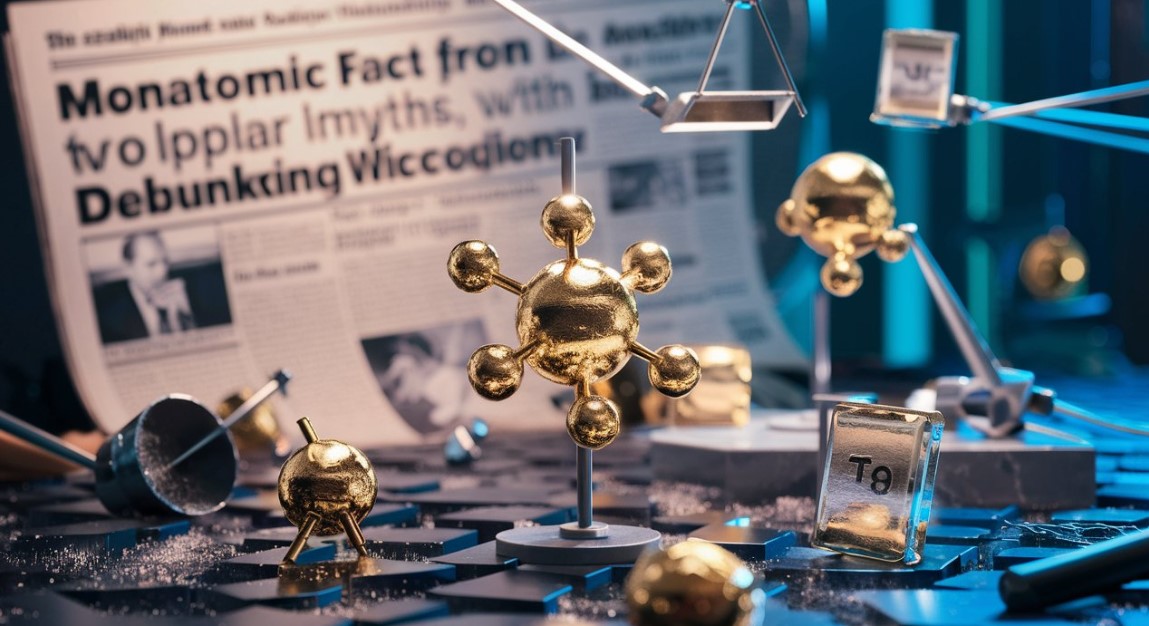
In recent years, there has been growing interest in monatomic elements, particularly monatomic gold (also known as Ormus gold or white powder gold). Proponents claim these substances have extraordinary properties and health benefits. However, there needs to be more scientific evidence to support many of these claims, and much of the information online comes from unreliable sources. This article aims to provide an objective overview of monatomic elements, analyze the current state of research, address critical challenges, and offer practical advice for those interested in this topic.
Understanding the Basics
Monatomic elements, as the name suggests, refer to substances composed of single atoms not bound to each other. This contrasts the bulk form of elements, which consists of clusters of atoms in a crystalline lattice structure. Under standard conditions, nearly all elements exist in a polyatomic state. The theory behind monatomic elements arose from the work of David Hudson, a farmer who discovered a strange white powder on his land in the 1970s. Hudson claimed this powder contained monatomic precious metals like gold and platinum1.
The term “Ormus” is sometimes used interchangeably with monatomic elements. Ormus is an acronym for “Orbitally Rearranged Monoatomic Elements”. The idea is that the electrons in these elements exist in a high-spin state, giving them unique properties. However, this theory is not supported by mainstream science.

From a scientific perspective, it is possible to create monatomic gold, but it requires specific laboratory conditions. Researchers have successfully produced monatomic gold wires and films using techniques like electron beam lithography48. These nanostructures exhibit interesting electronic and optical properties due to quantum confinement effects. However, they are highly unstable and tend to merge into clusters unless kept under controlled conditions.
Analyzing Current Trends
Despite lacking scientific backing, monatomic gold and other elements have gained a following in alternative health and spirituality circles. Many websites and online marketplaces sell Ormus supplements claiming a wide range of benefits – from enhanced cognitive function and anti-ageing effects to spiritual enlightenment15. However, these products are unregulated, and their purity, safety or efficacy is not guaranteed.
Some studies have investigated the biological effects of gold nanoparticles, which are larger than single atoms but still exhibit unique properties compared to bulk gold. Gold nanoparticles have shown potential in applications like cancer therapy, drug delivery, and imaging1617. However, these effects are due to the size and surface properties of the nanoparticles, not because they are monatomic. More research is needed to fully understand the pharmacokinetics and toxicity of gold nanoparticles before they can be widely used in medicine.
There is also interest in the catalytic properties of gold nanoclusters and films, which have high surface area and reactivity. Gold nanostructures are being explored for pollution control, chemical synthesis, and fuel cells. Again, these effects are not unique to monatomic gold but result from nanoscale size effects.
Challenges and Solutions
One of the biggest challenges in researching monatomic elements is separating legitimate scientific inquiry from pseudoscience and misinformation. Many bold claims about Ormus gold can be traced back to misinterpretations of scientific concepts like quantum physics and alchemy. Properly educating the public about the natural science behind these topics is essential to combat the spread of false information.
Another area for improvement is the difficulty characterizing and studying single atoms of elements like gold. Due to their instability, monatomic gold samples rapidly aggregate unless kept under high vacuum or cryogenic conditions. Specialized analytical techniques like aberration-corrected electron microscopy and synchrotron X-ray absorption spectroscopy are needed to probe the atomic structure and electronic states of these materials. Developing more accessible and scalable synthesis methods is an ongoing area of research.
The environmental and ethical impacts of gold mining are another critical consideration. Gold extraction is energy-intensive and relies heavily on toxic chemicals like mercury and cyanide. Supporting the development of sustainable and eco-friendly gold recovery methods, such as phytomining and bioleaching, can help mitigate these harms. Promoting recycling and responsible sourcing of gold is also critical.
Expert Insights
According to Dr. Ulrich Starke, a researcher at the Max Planck Institute for Solid State Research, “Two-dimensional layers of gold and silver were produced by our team. The extreme of a layer that is only one atom thick behaves like a semiconductor. This demonstrates that electrons behave differently in the two-dimensional layer of a material than in three-dimensional structures.”
This highlights that monatomic gold can exhibit unique electronic properties, but these effects are due to reduced dimensionality, not because the atoms are isolated. Dr. Starke emphasizes that producing stable monolayers of gold is challenging and requires carefully controlled conditions.
Professor Mathias Brust, Chair of Nanomaterials at the University of Liverpool, states, “There is no doubt that gold nanoparticles and clusters have interesting optical, electronic, and catalytic properties. However, scientific evidence does not support many of the health claims surrounding monatomic gold. More rigorous studies are needed to evaluate the efficacy and safety of these products.”
Practical Advice
For those interested in the potential benefits of gold, it’s essential to be cautious of unsubstantiated health claims. Ingesting gold in any form is not without risks, as it can accumulate in tissues and cause side effects. Always consult with a qualified healthcare professional before taking gold supplements.
If you’re considering purchasing monatomic gold or Ormus products, be sure to do thorough research on the supplier. Look for third-party lab testing results to verify the purity and composition of the product. Be wary of any company making exaggerated or pseudoscientific marketing claims.
From a scientific research perspective, those interested in studying monatomic elements should focus on well-defined nanomaterials like gold clusters and quantum dots. Collaborating with experts in nanoscience, surface science, and advanced characterization techniques is crucial to rigorously investigate these materials. Proper safety precautions must always be followed when handling nanoparticles.
What Are The Benefits Of Monatomic Gold For Brain Health And Pineal Gland Function
Based on the search results, here are the key potential benefits of monatomic gold (also known as Ormus gold or white powder gold) for brain health and pineal gland function:
It may help decalcify and activate the pineal gland, which produces melatonin and regulates sleep cycles. Calcification of the pineal gland is theorized to impair its function.
It improves mental clarity, focus, memory, creativity, and overall cognitive function by increasing communication between the brain hemispheres. However, these effects have yet to be scientifically proven.
Some believe her to repair DNA damage in the brain and body, although this is not supported by research.
Anecdotally reported to enhance spiritual experiences, lucid dreaming, and intuition by stimulating the pineal gland. The pineal gland has been called the “seat of the soul.”
It may increase alpha brain wave activity, which is associated with relaxation and learning. However, EEG studies still need to be included.
They are theorized to improve the brain’s ability to use copper, essential for neuron signaling. Copper imbalances are linked to neurological disorders.
However, it’s important to note that rigorous scientific evidence does not support the claimed benefits of monatomic gold. Experts state there is no such thing as “monatomic” gold and that ingesting gold will not improve brain function, as gold cannot cross the blood-brain barrier unless in nanoparticle form1. The purity and safety of many monatomic gold supplements are also questionable.
While some animal studies suggest gold nanoparticles could have neuroprotective effects, this differs significantly from the monatomic gold powders and supplements marketed online. More research is needed to determine if gold-based compounds can support human brain health when used correctly. The decalcification and activation of the pineal gland by monatomic gold remains a theory without scientific backing.

Conclusion
In summary, monatomic gold and other elements are an intriguing area of research, but much of the information circulating online needs to be more accurate and substantiated. While it is possible to create monatomic gold under specific lab conditions, scientific evidence does not support the extraordinary properties and health benefits claimed by some proponents. Gold nanostructures do exhibit unique electronic, optical, and catalytic effects, but these are due to their nanoscale dimensions rather than being monatomic.
We must support rigorous, evidence-based research into nanomaterials while combating pseudoscience and misinformation. Developing sustainable and responsible practices for gold mining and promoting recycling are fundamental challenges that must be addressed. By working together across disciplines and engaging in open, honest communication, we can unlock the real potential of monatomic elements and nanotechnology while avoiding false promises and unintended consequences.